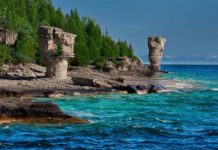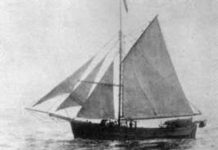
Scouting for coal and other resources and the best routes for new railways, geologists explored the Red Deer River valley in southern Alberta in the early 1880s. Members of the Geological Survey of Canada (GSC) carefully examined the Badlands terrain for signs of the precious coal fuel. Teams working with GSC Director and field geologist George M. Dawson collected samples and completed crucial surveys.
In the summer of 1884, Joseph B. Tyrrell and his group of three men were canoeing the Red Deer River near Drumheller, investigating the Cretaceous outcroppings – small fossils had been found by Dawson a decade earlier. Tyrrell climbed a steep rock face and rounded the point to examine a peculiar shape in the earth. Clearing away the dirt and dust, the 26-year-old scientist was taken by surprise.
The Fossil Skull of a Dinosaur Found in Alberta Badlands
“There was this skull leering at me, sticking right out of the ground,” Tyrrell described nearly seven decades after his find. The sight gave him a fright, he said. “With his hands and his geologist’s hammer, he gradually uncovered the fossilized skeleton of a dinosaur,” noted the Historica Minutes Synopsis on “Joseph Tyrrell.” While not a palaeontologist, Tyrrell was able to expertly extract the skull fossil and transport it to Calgary for examination. The bones were named a month later: Albertosaurus.
Tyrrell Found Albertosaurus Sarcophagus
Meaning “Alberta Lizard”, Albertosaurus was of the genus sarcophagus, determined by American Museum of Natural History palaeontologist Henry Fairfield Osborn in 1905. It was the same year Alberta became a province of Canada. The dinosaur was a theropod, using its massive back legs to walk on two feet. Albertosaurus was a member of the Tyrannosaurid family with stubby, small arms and two fingers on each hand, similar to the later Tyrannosaurus Rex. Living 70 million years ago in the late Cretaceous, Albertosaurus weighed in at about two metric tons with a length of 11 metres.
A hungry carnivore, the Albertan predator feasted on other dinosaurs, shredding the meat with its long, saw-toothed jaws. Albertosaurus “may have went after fleeter prey, like duck-billed dinosaurs and orthomimids,” said Rare Resource’s entry on “Albertosaurus Dinosaur.” Fossils of the large dinosaur were later also located in the mid-west United States.
Fossil Fields in Dinosaur Provincial Park
In 1888, the GSC sent Thomas C. Weston to the Red Deer River valley as the Dominion of Canada’s official fossil hunter. “Weston,” said Dinosaur Provincial Park, “was the first person to not just explore, but to publish his findings on the section of the valley that would later become the [Dinosaur Provincial] park.” Named in 1979 a UNESCO World Heritage site, the park has some of the largest dinosaur fossil fields in the world. In the Drumheller area, the years 1910 to 1917 were dubbed the “Great Dinosaur Rush”, said the Royal Tyrrell Museum. The era was so named because “palaeontologists from the United States and Canada came in droves, eager to claim the finest specimens for their Museums.”
Joseph Tyrrell’s spectacular find of the first Albertosaurus is celebrated at the Royal Tyrrell Museum in Drumheller, Alberta. Tyrrell is also recognized for finding expansive coal deposits that became an essential coal mining district. Frustrated because he was not promoted to higher posts, Tyrrell left the Geological Survey of Canada and became a mining consultant in Dawson City, Yukon, during the Klondike Gold Rush. He died at age 99 in 1957.
Sources:
- “Our History: the Naming of,” Royal Tyrrell Museum
- “Joseph Tyrrell: Synopsis,” Historica Minutes, Historica Dominion
- “Past Lives: Chronicles of Palaeontology, Tyrrell and Albertosaurus,” Geological Survey of Canada, Natural Resources Canada
- “Tyrrell, Joseph Burr (1859-1957),” Encyclopedia of Saskatchewan, University of Regina






